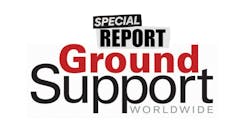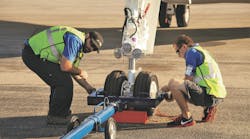We are often asked to assist in evaluating an aircraft for purchase. With a growing used aircraft inventory on the market it’s even more important to look hard at the aircraft and be sure it is the best value. There are several things to consider when you are looking for a good used aircraft. In this article we will discuss the more critical considerations and even touch a little on technique. A pre-purchase evaluation consists of two major elements: 1) physical inspection of the aircraft, and 2) an audit of the maintenance records.
Let’s stand back for a moment and consider the aircraft maintenance cycle in general. Each unique model has a different maintenance cycle timeline derived basically from its maintenance and inspection schedule, published by the aircraft manufacturer. Understanding where on that timeline that aircraft currently lies can be a huge factor in the valuation of the aircraft. Done right, the maintenance records audit can paint a timeline picture clearly. Imagine buying an aircraft that needs a major inspection, engine overhauls, and a landing gear inspection in the next 12 months. Once you own the aircraft you pay for the maintenance. Many focus only on the major maintenance events and ignore the little stuff. Well, lots of little stuff can quickly add up to a major maintenance event by itself.
Inspect the aircraft
In order to properly evaluate the physical condition of the aircraft an all-encompassing and complete inspection should be performed, even if it isn’t due yet. Obviously, the selection of a maintenance provider who will perform the inspection is important. The aircraft buyer is usually the party paying for the pre-purchase and usually selects the maintenance provider. We recommend choosing a maintenance provider with an outstanding reputation for knowledge on the make and model aircraft being purchased. Almost anyone can legally inspect the aircraft; however, a willingness to do the work does not equate to expertise. When making a buy decision on a multimillion dollar asset like an aircraft,you’ve got to find experts to help in the evaluation.
The general belief is that the best maintenance provider choice will be the aircraft OEM (original equipment manufacturer), but there are several non-OEM maintenance providers who are very capable as well.
More important than the facility is the specific mechanic or team leader who will perform the work. That is truly where the expertise lies. Use your network to find an expert on the aircraft make and model being purchased. Every maintenance organization has its strengths and weaknesses. You want to be certain that the maintenance provider you choose has a team that really knows the aircraft model in question and will know what to look for.
As for the scope and detail of the inspection, keep it simple. The equivalent of a 100-hour/annual inspection should be performed as part of the pre-purchase in order to uncover any possible hidden damage or corrosion. The 100-hour/annual inspection performed on small piston aircraft is intended to be a tip-to-tail inspection that, when performed, will uncover all possible airworthiness concerns. In the case of large or multi-turbine powered aircraft (Ref: Part 91.409 (e)), a “100-hour/annual” inspection is usually not available in the maintenance program provided by the manufacturer. However, it is not too difficult to find the equivalent of a 100-hour/annual inspection within the manufacturer’s inspection program. The manufacturer always has a group of inspections that, when combined, consist of a tip-to-tail inspection of the aircraft. If an aircraft is imported into the United States from another country, the regulations require that the “equivalent of a 100-hour/annual inspection” be performed (Ref: Part 21.183 (d)(2)). Because of this regulation, large and multi-turbine aircraft manufacturers can tell you what group of inspections contained within their maintenance program (when accomplished together) are “equivalent to a 100-hour/annual” type inspection.
A common shortcut that a buyer will take is to perform an abbreviated inspection based on the fact that some major inspection was just accomplished by a reputable maintenance provider. I disagree with that approach. I have seen several cases when the shortcut came back to bite the new owner. In all cases, a complete tip-to-tail inspection should be performed on the prospective aircraft.
Prior to beginning the inspection, the aircraft should be flown and an “at altitude” engine power check performed followed by ground power checks for comparison. During the ground power checks is the best time to perform avionics systems functional checks to find any possible high dollar equipment problems. I recommend that your selected expert technician participate in both flight and ground runs. Engine runs can tell a seasoned technician a lot about the condition of the engine. Always record any problems found during the aircraft operational checks so that during final runs you can make sure everything was corrected.
The physical inspection of the external and internal components of the engine is also a must. Engine problems can be expensive. The internal inspection should be, at minimum, a borescope inspection of the hot section and gas generator sections of the engine. It’s best, however, to have the engines disassembled enough for the technician to look directly at the hot section components and check for damage. For engines where disassembly is not practical, a borescope may be the only option. The fact is, borescope technology has come a long way and problems are much easier to see with the newer scopes. In all cases the inspection must be complete and detailed and performed by an expert. Again, engine components are extremely expensive — and if a serious problem exists, it needs to be uncovered as part of the pre-purchase.
Audit the maintenance records
Another component of the pre-purchase is the aircraft maintenance records audit. Please do not underestimate the importance of this part of the evaluation. Just as worn parts or hidden damage can come to the surface later in life and cost the buyer significantly, so can undocumented scheduled maintenance, life-limited parts, and inspections. The value of an aircraft can be dramatically affected by missing records or hidden damage to the aircraft. Sometimes as much as 15 to 20 percent of the value of the aircraft can be lost simply by maintenance documentation shortcomings. When you are dealing with a multimillion dollar aircraft, even 1 percent is huge. The audit is cheap insurance.
An aircraft maintenance record audit consists of the following checks at a minimum:
- Verification of the aircraft/engine/propeller total time in service
- Verification of all scheduled inspections and maintenance checks specified by the aircraft manufacturer (including the engines, props, appliances, and emergency and survival equipment (Ref: Part 91.409 (e))
- Identification of the chosen maintenance program for the aircraft
- Comparison (if necessary) to the manufacturer’s inspection program
- Verification of compliance with all applicable airworthiness directives
- Complete status of compliance with applicable service bulletins
- Evidence of possible damage history hidden within the records
- Completeness of all maintenance records including all FAA Form 337s and required supporting approved data for major alterations and major repairs (Ref: Part 91.417)
- Compliance with all instructions for continued airworthiness (ICAs) associated with any major alterations or supplemental type certificates
These checks are to be accomplished by conducting a complete and thorough examination of the maintenance records. To begin, organize the records and inventory them chronologically to facilitate the audit. We sometimes receive records in such disorder that half of the first day is spent organizing the records.
The audit begins by starting with the most recent logbook and the most recent logbook entry and moving backward through the records reading each entry carefully. It is important that the person performing the audit be familiar with the inspection and maintenance program for the aircraft. This will be helpful in making the maintenance records audit efficient since there are often several hundred scheduled maintenance or inspection tasks that must be documented in the records and extracted by the technician.
As the audit process continues and the information is found in the maintenance records, the technician should condense the findings in a format that will allow presentation of a summary of the data and the current status (next due) of each scheduled item, airworthiness directive, service bulletin, etc. In addition we also need to find any major alterations and/or major repairs. Major alterations are required to be recorded using FAA Form 337; however, the major repairs may be recorded using a signed copy of the work order if the work was performed by an FAA certificated repair station using approved data (Ref: Part 43 Appendix B (b)) and the repair station meets all of the criteria in Part 43 Appendix B.
Upon completion of the pre-purchase records evaluation, the buyer should be presented with a list of maintenance records deficiencies. Since the messenger usually is the first one to get shot at, we suggest that the proper approach be taken regarding the deficiencies. The deficiency in the records does not mean that the work has not been accomplished, it simply means that the work was not found signed off in the maintenance records provided.
The deficiencies are then either addressed by the maintenance provider or further documentation is provided by the seller that shows that the work was done. Once all questions can be answered or otherwise addressed, the records are completed and will then accurately reflect compliance with all the maintenance requirements.
Most aircraft purchase agreements include a pre-purchase section that spells out the responsibilities and limitations of the pre-purchase inspection. Usually the buyer pays for the inspection and the seller pays to have discrepancies corrected prior to the closing of the sale. Another detail to understand is that there is often a limitation to the time allowed to perform the inspection. Make certain that you have ample time to complete the necessary inspections and checks so that you know what you are buying.
No shortcuts
The pre-purchase inspection is too often cut short. Sometimes the buyer just falls so in love with the aircraft that it doesn’t matter what is wrong with it. Or maybe the buyer doesn’t see the need to spend the money. (“Why should we do that inspection? The aircraft just came out of a major inspection.”) The time at which the aircraft transfers from one owner to another is the best time to spend the money to inspect it. That’s the only time when the buyer and seller are both at the table with their checkbooks and that an agreement on the airworthiness of the aircraft indicates who is responsible for what expenses. A pre-purchase evaluation will certainly uncover airworthiness related concerns; however, once the pre-purchase evaluation is completed and all the discrepancies found are corrected, the buyer can rest easy knowing where in the maintenance cycle the new aircraft is and what expenses to expect related to future maintenance requirements. And the aircraft can be put into service for its intended purpose.
This article has been updated for today’s economic climate; an article on the same topic appeared in 2006.
Joe Hertzler is the CEO and co-founder of Avtrak Inc., provider of the industry’s first Internet-based and compliance-focused maintenance tracking service — Avtrak GlobalNet. Avtrak has earned a solid reputation for having the most comprehensive and easy-to-use compliance management system and service in the industry. Avtrak’s GlobalNet technology is the engine behind Gulfstream CMP.net and Sikorsky HelotracII. GlobalNet is the system of choice for many operators of more than 140 models including Bombardier, Hawker/Beechcraft, and Dassault Falcon aircraft.




